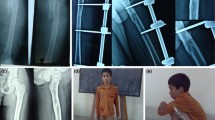Abstract
Flexible intramedullary nailing (FIN) is the gold standard treatment for femur fracture in school-aged children. It has been performed successfully in younger children, although Spica cast immobilisation (SCI) has been the most widely used strategy to date.
Method
A retrospective analysis was performed between two comparable groups of children aged 1–4 years with a femoral shaft fracture. Two University hospitals, each using specific treatment guidelines, participated in the study: SCI in Group I (Basel, Switzerland) and FIN in Group II (Lausanne, Switzerland).
Results
Group I included 19 children with a median age of 26 months (range 12–46 months). Median hospital stay was 1 day (range 0–5 days) and casts were retained for a median duration of 21 days (range 12–29 days). General anaesthesia was used in six children and sedation in four. Skin breakdown secondary to cast irritation occurred in two children (10.5%). The median follow-up was 114 months (range 37–171 months). No significant malunion was noted. Group II included 27 children with a median age of 38.4 months (range 18.7–46.7 months). Median hospital stay was 4 days (range 1–13 days). All children required general anaesthesia for insertion and removal of the nails. Free mobilisation and full weight bearing were allowed at a median of 2 days (range 1–10 days) and 7 days (range 1–30 days), respectively, postoperatively. Nail exteriorisation was noted in three children (11%). The median follow-up was 16.5 months (range 8–172 months). No significant malunion was reported.
Conclusions
Young children with a femoral shaft fracture treated by SCI or FIN had similarly favourable outcomes and complication rates. FIN allowed earlier mobilisation and full weight bearing. Compared to SCI, a greater number of children required general anaesthesia. In a pre-school child with a femoral shaft fracture, immediate SCI applied by a paediatric orthopaedic team following specific guidelines allowed early discharge from hospital with few complications.



Similar content being viewed by others
Notes
AAOS: American Academy of Orthopaedic Surgeons.
References
Flynn JM, Luedtke LM, Ganley TJ, Dawson J, Davidson RS, Dormans JP, Ecker ML, Gregg JR, Horn BD, Drummond DS (2004) Comparison of titanium elastic nails with traction and spica cast to treat femoral fractures in children. J Bone Joint Surg Am 86:770–777
Simanovsky N, Porat S, Simanovsky N, Eylon S (2006) Close reduction and intramedullary flexible titanium nails fixation of femoral shaft fractures in children under 5 years of age. J Pediatr Orthop B 15:293–297
Bopst L, Reinberg O, Lutz N (2007) Femur fracture in preschool children: experience with flexible intramedullary nailing in 72 children. J Pediatr Orthop 27:299–303
Anglen JO, Choi L (2005) Treatment option in pediatric femoral shaft fractures. J Orthop Trauma 19:724–733
Berne D, Mary P, Damsin JP, Filipe G (2003) Femoral shaft fracture in children: treatment with early spica cast. Rev Chir Orthop 89:599–604
Th D’Ollonne, Rubio A, Leroux J, Lusakisimo S, Hayek T, Griffet J (2009) Early reduction versus skin traction in the orthopaedic treatment of femoral shaft fractures in children under 6 years old. J Child Orthop 3(3):209–215
Stans AA, Morrissy RT, Renwick SE (1999) Femoral shaft fracture treatment in patients age 6 to 16 years. J Pediatr Orthop 19:222–228
Metaizeau JP (2004) Stable elastic intramedullary nailing for fractures of the femur in children. J Bone Joint Surg Br 86:954–957
Flynn JM, Schwend RM (2004) Management of pediatric femoral shaft fractures. J Am Acad Orthop Surg 12:347–359
Sanders JO, Browne RH, Mooney JF, Raney EM, Horn BD, Anderson DJ, Hennrikus WL, Robertson WW (2001) Treatment of femoral fractures in children by pediatric orthopedists: results of a 1998 survey. J Pediatr Orthop 21:436–441
Kocher MS et al (2009) Treatment of pediatric diaphyseal femur fractures. J Am Acad Orthop Surg 17:718–725
Mutimer J, Hammett RD, Eldridge JD (2007) Assessing leg length discrepancy following elastic stable intramedullary nailing for paediatric femoral diaphyseal fractures. Arch Orthop Traumat Surg 127:325–330
Author information
Authors and Affiliations
Corresponding author
About this article
Cite this article
Jauquier, N., Doerfler, M., Haecker, FM. et al. Immediate hip spica is as effective as, but more efficient than, flexible intramedullary nailing for femoral shaft fractures in pre-school children. J Child Orthop 4, 461–465 (2010). https://doi.org/10.1007/s11832-010-0279-1
Received:
Accepted:
Published:
Issue Date:
DOI: https://doi.org/10.1007/s11832-010-0279-1




